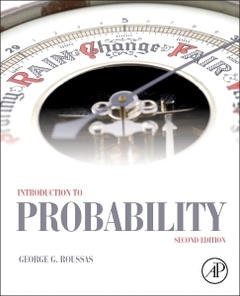Introduction to Probability (2nd Ed.)
Auteur : Roussas George G.

Introduction to Probability, Second Edition, discusses probability theory in a mathematically rigorous, yet accessible way. This one-semester basic probability textbook explains important concepts of probability while providing useful exercises and examples of real world applications for students to consider.
This edition demonstrates the applicability of probability to many human activities with examples and illustrations. After introducing fundamental probability concepts, the book proceeds to topics including conditional probability and independence; numerical characteristics of a random variable; special distributions; joint probability density function of two random variables and related quantities; joint moment generating function, covariance and correlation coefficient of two random variables; transformation of random variables; the Weak Law of Large Numbers; the Central Limit Theorem; and statistical inference. Each section provides relevant proofs, followed by exercises and useful hints. Answers to even-numbered exercises are given and detailed answers to all exercises are available to instructors on the book companion site.
This book will be of interest to upper level undergraduate students and graduate level students in statistics, mathematics, engineering, computer science, operations research, actuarial science, biological sciences, economics, physics, and some of the social sciences.
- Demonstrates the applicability of probability to many human activities with examples and illustrations
- Discusses probability theory in a mathematically rigorous, yet accessible way
- Each section provides relevant proofs, and is followed by exercises and useful hints
- Answers to even-numbered exercises are provided and detailed answers to all exercises are available to instructors on the book companion site
Date de parution : 01-2014
Ouvrage de 546 p.
19x23.3 cm
Thème d’Introduction to Probability :
Mots-clés :
<; mmlmath altimg="si20.gif">; <; mmlmrow>; <; mmlmi>; F<; /mmlmi>; <; /mmlmrow>; <; /mmlmath>; -distribution; <; mmlmath altimg="si21.gif">; <; mmlmrow>; <; mmlmi>; T<; /mmlmi>; <; /mmlmrow>; <; /mmlmath>; -distribution; Analysis of variance; Axiomatic definition; Bayes formula; Binomial experiment; Bivariate; Calculus; Calculus matter; Center of gravity; Chemotherapy; Chi-square; Classical definition; Combinations; Conditional probability; Conditional variance; Constants; Continuity correction; Continuity points; Continuous type; Correlation coefficient; Criterion of independence; DeMorgan's Laws; Degrees of freedom; Dispersion; Distribution; Equipment; Estimator; Event; Events; Expectation; Factorization; Gamma function; Hypergeometric; Inertia; Integration; Intersection; Inverse transformation; Inversion formula; Joint probability distribution; Keywords Permutations; Keywords Transformations; Landfills; Lifespan; Lifetime; Likelihood function; Limit; Linear combination; Linearity; Mathematical induction; Mean value; Measurements; Median; Mode; Moment; Moment-generating function; Moments; Monotone; Monotonicity; Multinomial distribution; Multivariate distribution; Null hypothesis; Pairwise disjoint; Parameter space; Parameters; Partial derivatives<; !--Query id="Q1" desc="Please check and approve the insertion of keywords." /-->; Partition; Pine seedlings; Plausibility arguments; Pointwise convergence; Poisson distribution; Posterior probabilities; Probability density function; Probability model; Proportions; Proposition; Random error; Random experiment; Random variable; Recursive function; Rejection region; Relative frequency; Reparameterization; Sample mean; Sample points; Sample space; Solid curve; Standard deviation; Standard deviations; Statistical inference; Statistics; Summations; Taylor's formula; Total Probability Theorem; Unconditional probability; Union; Variance; Variation; Venn diagram; Viewpoint; Waiting time
